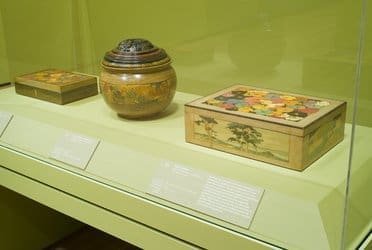California as Muse: The Art of Arthur and Lucia Mathews
Karl and Bertl Arnstein Galleries
Two of California’s most important early twentieth century artists are finally being rediscovered by the rest of the country. California as Muse presents almost seventy paintings, drawings, furniture and decorative pieces by Arthur and Lucia Mathews, who strove to unite the fine and applied arts. A lavishly illustrated, long-awaited book on the couple accompanies the show. Both book and exhibition are part of a major re-evaluation of the impact of the style they developed, the California Decorative Style, and its role in American art.
Arthur Mathews (1860-1945) had served apprenticeships in architectural draftsmanship, graphic design and illustration, but by the time the couple met, he was an established painter who had studied, exhibited and won medals in Paris. Returning to San Francisco, Arthur taught at the Mark Hopkins Institute of Art and became its director. Lucia Kleinhans (1870-1955) spent a year at Mills College before coming to the Institute in 1893, where she was one of Arthur’s students. Arthur and Lucia married in 1894 and toured Europe in 1898-99, returning to San Francisco so Arthur could resume teaching. He also pursued his career as an artist, exhibiting paintings and winning commissions for murals in lavishly decorated homes and public buildings. Lucia continued painting and explored graphic design and illustration.
Their lives changed on Wednesday, April 18, 1906, when the great San Francisco earthquake struck. The quake and resulting fires destroyed the Hopkins Institute of Art and Arthur’s studio, although he was able to rescue a number of his paintings. The economic and social impact of the quake was comparable to that of Hurricane Katrina on New Orleans. Around 80% of San Francisco was decimated, leaving a blank slate upon which to rebuild.
The Mathews dreamed of transforming San Francisco into a new Utopia, one imbued with the luminosity of the California landscape, the harmony of classical art, the grace of Art Nouveau and the populist ideals of the Arts & Crafts movement. Arthur quit his post at the Institute. Gathering around them artisans, architects, developers and city planners, the Mathews urged politicians and builders to re-conceptualize the city by incorporating aesthetic standards into the design and production of practical necessities.
The couple showed the way, partnering almost immediately after the quake with a local entrepreneur to establish the Furniture Shop. Employing up to fifty craftsmen in its heyday, it combined art with commerce, creating artful products from furniture, lamps, candlesticks and vases to picture frames. A number of civic leaders bought into the Mathews’ vision and commissioned items for residential, commercial and public interiors. Arthur supervised the shop and designed the furniture, sometimes in collaboration with Lucia, who supplied most of the decoration.
Both artists also maintained their own studios. They sometimes collaborated, but each retained a distinctive style. Arthur was firmly rooted in nineteenth century traditions of landscape and the figure. In great demand as a muralist and easel painter, his images often draw on classical references, placing mythological figures in idyllic California settings. Lucia’s portraits of women and children and her landscapes owe a debt to James McNeill Whistler, with whom she studied in Paris. Her floral works and graphic and decorative designs evoke the sinuous forms and all-over patterns of Art Nouveau and the Arts & Crafts movement.
When Arthur’s health began to fail in the 1930s, the couple withdrew from the public arena. As decades passed, tastes changed and the California Decorative Style fell out of favor. This exhibition, drawn from the collection of the Oakland Museum of California, is a rare opportunity to visit, even if just for an hour or so, the Utopia created by Arthur and Lucia Mathews.
This exhibition was organized by The Oakland Museum of California, which acknowledges the following contributors: The Oakland Museum Women’s Board; The Brayton Wilbur Foundation; the Art Guild of the Oakland Museum of California; The National Endowment for the Arts; Mr. and Mrs. Maurice Holloway; and Nancy Stryble, in memory of Francis and Margaret Stryble.
Presentation in Akron is made possible by major sponsorship from Akron Community Foundation with generous support from the David H. & Barbara M. Jacobs Foundation and Merrill Lynch.

